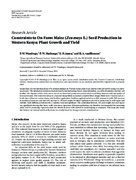| dc.description.abstract | Studies have shown that that about 85% of maize farmers in Western Kenya plant local varieties with about 80% using own farm-saved seeds. The production system is characterized by late harvesting, heavy striga infestation, use of local varieties, and low-soil fertility. The objective of this study was to test an on-farm seed production system which would help improve yield and quality of farm saved seeds. The trials were set up in a factorial design fitted as random complete block design. There were 3 factors each at 2
levels: time of harvest, variety choice, and fertilizer application. Fertilizer application led to an 88% increase in yield, 54% increase in number of seeds per cob, and 14% increase in 100-seed weight. Fertilizer application also led to an increase in seed vigour and
viability. Yield differences between the 2 varieties were not significant. The correlation between 100-seed weight and seed vigour was significant showing that heavy seeds were more vigorous. Nitrogen application was therefore recommended for increasing
yields and for producing vigorous seeds but should be done with caution to avoid lodging as witnessed. This study also noted that farmers are rational and their decisions are usually based on strong economic considerations. | en_US |
